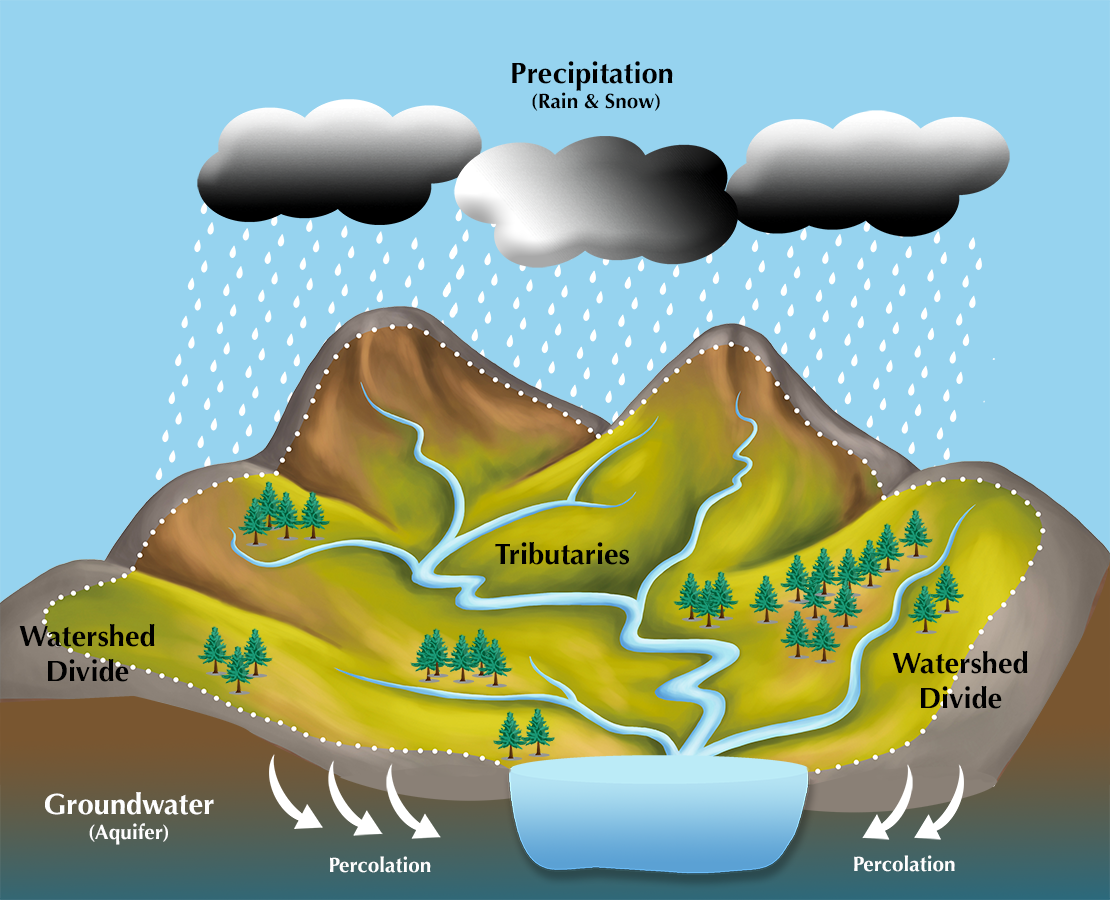What is a watershed?
A watershed is the land area that drains to a common body of water, such as a stream, lake, bay, or even the ocean. They provide drinking water, habitats for wildlife, soil to grow our food, and locations for fishing, boating and swimming. We all live in a watershed.
Rain that does not soak into the ground becomes runoff and carries soil, pollutants, and other materials from the land into our rivers, lakes and bays. Our everyday activities can affect downstream waters.
 Source: Kim Roberts, Center for Watershed Protection
Source: Kim Roberts, Center for Watershed Protection
Here are 10 things you can do to protect your watershed:
- REDUCE ROOFTOP RUNOFF: Excess runoff can cause flooding and stream bank erosion during rainstorms. Minimize runoff by redirecting downspouts into vegetated areas, installing rain barrels or planting a rain garden. Use the stored water for your garden and other landscaping.
- MINIMIZE FERTILIZER: Nutrients from fertilizer runoff can lead to excess plant and algae growth in waterways. Have your soil tested to determine fertilizer needs and only apply the recommended amount of each nutrient.
- MAINTAIN YOUR SEPTIC SYSTEM: Septic system failures can be costly and can contaminate groundwater and nearby surface waters. Have your septic system inspected and pumped every three years.
- SCOOP THE POOP. Pet waste left out in the yard, on sidewalks or on roadsides washes away when it rains and is a major contributor to bacteria problems in local waterways. Dispose of pet waste properly by putting it in a sealed bag in the trash, flushing it down the toilet, or burying it in your yard.
- PROPERLY DISPOSE OF HOUSEHOLD HAZARDOUS WASTE: Never pour chemicals, pharmaceuticals, oil or paint into the storm drain. Check with your county’s household hazardous waste program to properly dispose of or recycle chemicals and keep them out of your waterways.
- GO NATIVE: Reduce your lawn by adding native trees, shrubs and herbaceous plants to your landscape. They require less water and fertilizer and are more resistant to pests and disease since they are already adapted to local conditions.
- PLANT A STREAM BUFFER: If you have a stream on your property, provide a natural buffer of native trees and shrubs along its banks to help filter polluted runoff, control erosion, and provide essential fish and wildlife habitat.
- USE COMMERCIAL CAR WASHES: The best place to wash your car is at a commercial car wash, many of which filter their water before directing it to treatment plants. If you wash your vehicle at home, park it on the grass first, so your lawn absorbs some of the detergent runoff and contaminants.
- BE WATER WISE: Conserve water by using low-flow faucets, showers, and toilets, repairing leaks, taking shorter showers, and turning off the tap when brushing your teeth. Run dishwashers and clothes washers only when full, and wash your car and water your lawn only when necessary. You will not only be conserving water but also saving money!
- GET INVOLVED: We all live in a watershed, and every drop counts. Do your part by joining your local watershed organization, participating in community clean-ups, and supporting environmental legislation.
To find your watershed, go to USGS’s Locate Your Watershed. To learn more about the condition of your watershed, check out EPA’s How’s My Waterway.
 Facts about watersheds:
Facts about watersheds:
- Everyone lives in a watershed. The U.S. Geological Survey has divided the Nation into approximately 160,000 watersheds with an average size of 40 square miles.
- Nearly half of our rivers and streams and more than one-third of our lakes are polluted and unfit for swimming, fishing, and drinking.
- Leading problems in our rivers and streams include nutrient pollution, loss of shoreline vegetation and excess sediment.
- The amount of pavement and buildings present in a watershed is a good indicator of the condition of its streams. As coverage by these hard surfaces increases, stream health tends to decline accordingly. In the contiguous U.S., urban impervious surfaces, such as roads, buildings and parking lots, cover 43,000 square miles— an area nearly the size of the State of Ohio.
- Tree cover in urban/community areas of the U.S. is on the decline at a rate of about 175,000 acres per year, and the estimated loss of benefits from trees in urban areas is conservatively valued at $96 million per year.
